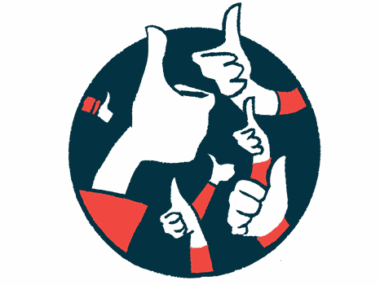Orladeyo effective for HAE with normal C1-inhibitor
Case series shows treatment cuts attack frequency, duration
Written by |

Switching to Orladeyo (berotralstat) may help reduce the frequency and duration of swelling attacks in people with hereditary angioedema (HAE) who have normal levels and activity of a protein called C1-inhibitor, according to a European case series.
These data add “clinically relevant evidence” to a growing body of reports that Orladeyo, an oral medication sold by Biocryst Pharmaceuticals to prevent swelling attacks, may be effective for patients with rarer types of HAE not caused by a low or faulty C1-inhibitor.
“The diagnosis of HAE patients with normal C1-inhibitor is complicated and often delayed by the lack of an easily measurable biochemical marker,” Isabelle Boccon-Gibod, MD, an HAE specialist at France’s Grenoble Alps University Hospital, said in a company press release.
Boccon-Gibod shared details of the case series in a presentation, “Effectiveness and safety of berotralstat in patients with hereditary angioedema with normal C1-inhibitor: A European case series,” at the European Academy of Allergy and Clinical Immunology (EAACI) Congress, held May 31-June 3 in Valencia, Spain.
Angioedema occurs when fluid builds up under the skin or in mucous membranes, resulting in swelling. In HAE, this is due to genetic mutations that lead to the production and release of bradykinin. Excess bradykinin causes blood vessels to become more permeable and leak fluid into tissues.
Limited treatment choices for some
Unlike HAE types 1 and 2, which occur due to mutations that result in low or faulty C1-inhibitor protein, HAE type 3 doesn’t affect the levels or the activity of C1-inhibitor. Treatment for this type of HAE may include attenuated androgens or other medications, which carry risks and aren’t always effective.
The case series involved six people with HAE who had normal levels and activity of C1-inhibitor. All switched to Orladeyo after being on long-term prophylactic (preventive) treatment. One continued on prophylactic treatment with tranexamic acid along with Orladeyo.
Taken as oral capsules by mouth, Orladeyo works by inhibiting the activity of kallikrein. This enzyme is needed to form bradykinin from its precursor molecule. Inhibiting kallikrein lowers the levels of bradykinin and prevents swelling attacks.
After six months of treatment with Orladeyo, five of the six patients experienced a reduction in how often they had swelling attacks, by as much as 75% to 100%. The patient who was on tranexamic acid alongside Orladeyo saw the attack rate drop by 29%.
Side effects were reported in one patient, who experienced gastrointestinal problems that became mild after two weeks and did not lead to treatment discontinuation.
The findings suggest that Orladeyo “can also reduce the frequency and duration of episodes in the C1 normal population,” offering a treatment option for a group of patients who previously had limited choices with potential side effects, Boccon-Gibod said.
Attenuated androgens, or male hormones, have been used to prevent swelling attacks in people with HAE, but they come with serious side effects. As a result, many doctors have become cautious about prescribing them, especially with safer alternatives becoming available.
Shift away from other treatments
New findings from a study, “Adverse Health Outcomes and Patient and Physician Perspectives of Attenuated Androgen Use in Hereditary Angioedema,” also presented at the congress, support a shift away from attenuated androgens and toward choices that align with World Allergy Organization/EAACI guidelines.
“Safer and more tolerable treatment options should be preferred and made accessible for HAE prophylaxis,” said Marcus Maurer, MD, a professor of dermatology and allergology at Charité Universitätsmedizin Berlin in Germany and co-director of the Fraunhofer Institute for Translational Medicine and Pharmacology.
The study reviewed 108 reports published from 1980 to mid-2023 on the use of attenuated androgens in people with HAE. Side effects of attenuated androgens included weight gain, irregular periods, masculinization, muscle pain, acne, and liver damage, including liver cancer.
Both patients and doctors were concerned about these side effects, leading to an increase in the proportion of doctors unwilling to prescribe attenuated androgens, from 18% in 2010 to 60% in 2019, according to a survey conducted in the U.S.
“This study presents the latest and largest body of evidence documenting that HAE prophylactic treatment with attenuated androgens is associated with short-term adverse outcomes and serious long-term risks that include increased cardiovascular events, liver damage, and cancer,” Maurer said. The findings, which come from a large set of reports, underscore the urgent need for making safer and better-tolerated treatment options available for people with HAE, he said.







